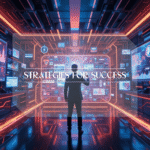Now Reading: Living Limitless: Break Free from Boundaries & Transform Your Life
-
01
Living Limitless: Break Free from Boundaries & Transform Your Life

Living Limitless: Break Free from Boundaries & Transform Your Life
Introduction
What if the only thing standing between you and an extraordinary life is your own perception of what’s possible? Living limitless isn’t about ignoring reality or pretending obstacles don’t exist—it’s about recognizing that most of our boundaries are self-imposed mental constructs that can be dismantled, rebuilt, or transcended entirely. This comprehensive guide explores the psychology of limitations, practical strategies for boundary-breaking, and actionable steps to cultivate a truly limitless mindset that transforms how you approach challenges, opportunities, and life itself.
Understanding the Nature of Boundaries
Boundaries come in many forms, and not all are created equal. Some boundaries are necessary and healthy—they protect our well-being, maintain relationships, and provide structure to our lives. However, many of the limitations we accept as absolute truth are actually learned behaviors, inherited beliefs, or fear-based constructs that no longer serve our highest potential.
Internal Boundaries are the mental and emotional barriers we create within ourselves. These include limiting beliefs like “I’m not smart enough,” “I don’t deserve success,” or “People like me don’t achieve great things.” These boundaries often stem from childhood experiences, societal conditioning, or past failures that we’ve internalized as permanent truths about our capabilities.
External Boundaries appear as circumstances, resources, or environmental factors that seem to limit our options. While some external constraints are genuine—such as physical laws or finite resources—many are simply challenges waiting for creative solutions or different approaches.
Social Boundaries emerge from cultural expectations, family traditions, or peer pressure that dictate what we should or shouldn’t pursue. These invisible barriers can be particularly powerful because they’re reinforced by our social circles and seem “normal” within our communities.
The key to living limitless lies in developing the discernment to identify which boundaries serve us and which ones constrain our growth unnecessarily. For a deeper understanding of healthy boundary-setting practices, explore the Customer Loyalty Program Guide which demonstrates how successful businesses balance structure with flexibility.
The Psychology of Limitation vs. Expansion
Our brains are wired for survival, not success. This evolutionary programming creates a natural bias toward caution, conformity, and conservation of energy. While this served our ancestors well in dangerous environments, it can become a significant obstacle in modern life where growth, innovation, and risk-taking often determine our level of fulfillment and achievement.
Fixed Mindset vs. Growth Mindset represents one of the most fundamental distinctions in how we approach limitations. A fixed mindset views abilities, intelligence, and talents as static traits that cannot be significantly developed. This perspective creates rigid boundaries around what we believe we can achieve. In contrast, a growth mindset recognizes that most abilities can be developed through dedication, hard work, and strategic learning.
Neuroplasticity research reveals that our brains remain remarkably adaptable throughout our lives. The neural pathways that support limiting beliefs can be rewired through consistent practice of new thought patterns and behaviors. This scientific understanding provides a biological foundation for the possibility of transcending mental boundaries that once seemed permanent.
The Reticular Activating System (RAS) in our brains filters information based on what we believe is important or possible. When we operate from a limited mindset, our RAS filters out opportunities, solutions, and resources that could help us transcend our boundaries. By consciously expanding our sense of possibility, we can reprogram our RAS to notice and attract limitless opportunities.
Understanding these psychological mechanisms empowers us to work with our brain’s natural tendencies rather than against them. For comprehensive strategies on reshaping thought patterns and belief systems, consult the Brand Identity Essentials guide, which explores how core beliefs shape outward expression and results.
Identifying Your Personal Limitations
Before you can break free from boundaries, you must first become aware of where they exist in your life. Many limitations operate below the conscious level, influencing our decisions and actions without our explicit awareness.
Limiting Beliefs Audit: Create a comprehensive inventory of beliefs that might be constraining your potential. Common categories include:
- Money and wealth (“Rich people are greedy,” “Money doesn’t grow on trees”)
- Relationships (“I’m not good at relationships,” “I always get hurt”)
- Career (“I’m not leadership material,” “I need more experience first”)
- Health (“I have bad genetics,” “I’m too old to change”)
- Creativity (“I’m not artistic,” “I’m not the creative type”)
Pattern Recognition: Examine recurring themes in your life where you consistently encounter obstacles or feel stuck. These patterns often reveal underlying limiting beliefs or habitual responses that create self-fulfilling prophecies.
Emotional Triggers: Notice situations that provoke strong negative emotions like fear, anger, or resignation. These emotional responses often indicate areas where boundaries are particularly entrenched and may require additional attention and healing.
Success Ceiling Analysis: Identify areas where you seem to hit a consistent upper limit—perhaps you always quit just before achieving a major breakthrough, sabotage relationships when they become too good, or find ways to lose money whenever you start accumulating wealth.
Environmental Constraints: Assess your physical and social environment for factors that may be reinforcing limitations. This includes the people you spend time with, the media you consume, and the physical spaces where you live and work.
For practical exercises in identifying and transforming limiting patterns, reference the Storytelling Framework, which provides tools for rewriting the narratives that govern your life experience.
Strategies for Breaking Mental Boundaries
Once you’ve identified your limitations, the next step involves systematically dismantling them through proven psychological and behavioral techniques.
Cognitive Restructuring involves challenging and replacing limiting thoughts with more empowering alternatives. Instead of automatically accepting thoughts like “I can’t do this,” practice asking “How might I learn to do this?” or “What would need to be true for this to be possible?”
Progressive Exposure gradually expands your comfort zone by taking small, manageable steps beyond your current boundaries. If public speaking terrifies you, start by speaking up more in small group conversations, then progress to larger groups, and eventually to formal presentations.
Visualization and Mental Rehearsal help rewire neural pathways by creating detailed mental experiences of successfully transcending your limitations. Athletes have long used this technique to improve performance, and it’s equally effective for breaking through mental and emotional boundaries.
Reframing Techniques transform how you interpret challenges and setbacks. Instead of viewing obstacles as evidence of your limitations, practice seeing them as feedback, learning opportunities, or temporary delays on your path to limitless living.
Social Modeling involves studying and emulating individuals who have successfully transcended similar limitations. This provides both inspiration and practical strategies while demonstrating that what seems impossible is often simply unfamiliar.
Energy Management recognizes that breaking boundaries requires significant mental and emotional resources. Develop practices that restore and amplify your energy, including physical exercise, meditation, adequate sleep, and activities that bring joy and inspiration.
Building a Limitless Mindset
Creating sustainable change requires more than just removing limitations—it involves actively cultivating a mindset that naturally seeks expansion and possibility.
Abundant Thinking shifts focus from scarcity to opportunity. Instead of worrying about what you lack, train yourself to notice resources, possibilities, and potential in every situation. This doesn’t mean ignoring real constraints, but rather approaching them as creative challenges rather than impossible barriers.
Curiosity Over Certainty replaces the need to know exactly how something will work out with excitement about discovering new possibilities. Cultivate phrases like “I wonder what would happen if…” and “That’s interesting, let me explore further…”
Process Orientation focuses on growth and learning rather than just outcomes. When you derive satisfaction and identity from the journey of expansion rather than just the destination, you become naturally resilient to temporary setbacks and more willing to push boundaries.
Systems Thinking recognizes that everything is interconnected and that breakthrough in one area often catalyzes expansion in others. Invest in developing capabilities that serve multiple areas of your life simultaneously.
Experimental Attitude treats life as an ongoing laboratory where you can test assumptions, try new approaches, and gather data about what’s possible. This reduces the emotional stakes of any individual attempt while increasing your willingness to push boundaries.
Celebration Practice acknowledges and reinforces boundary-breaking successes, no matter how small. This positive reinforcement strengthens neural pathways associated with expansion and makes future boundary-breaking feel more natural and achievable.
Practical Tools for Limitless Living
Theory without application remains merely intellectual understanding. Here are concrete tools and practices that facilitate consistent boundary-breaking in daily life.
The 40% Rule suggests that when you feel completely exhausted or convinced you’ve reached your limit, you’ve actually only accessed about 40% of your true capability. This concept, developed by Navy SEALs, can be applied to mental, emotional, and creative challenges as well as physical ones.
Constraint Removal Exercises systematically eliminate one self-imposed limitation each month. Start with smaller boundaries to build confidence and momentum, then progress to larger, more significant constraints.
Possibility Journals capture ideas, opportunities, and inspirations that expand your sense of what might be achievable. Regular review of these entries helps maintain an expansive mindset and often reveals patterns or themes worth pursuing.
Boundary Partnerships involve connecting with others who share your commitment to limitless living. These relationships provide accountability, support, and fresh perspectives when you encounter particularly stubborn limitations.
Resource Maximization involves creatively leveraging existing assets, relationships, and capabilities in ways you haven’t previously considered. Often, the resources needed to transcend boundaries are already available but require innovative application.
Feedback Loops establish regular mechanisms for assessing progress and adjusting strategies. This might include monthly self-evaluations, quarterly goal reviews, or annual vision updates that ensure you’re continually expanding rather than settling into new comfort zones.
Overcoming Fear and Resistance
Fear is perhaps the most universal boundary that keeps people from living limitlessly. Rather than trying to eliminate fear entirely—which is neither possible nor advisable—develop skills for moving forward despite fear’s presence.
Fear Mapping involves identifying the specific fears underlying each limitation. Often, what appears to be one fear (like fear of failure) is actually a cluster of more specific concerns (fear of judgment, fear of financial loss, fear of wasting time) that can be addressed individually.
Graduated Risk-Taking builds confidence by starting with small risks and gradually increasing the stakes as your comfort with uncertainty grows. This approach prevents overwhelm while systematically expanding your risk tolerance.
Failure Reframing transforms failure from a boundary-reinforcing experience into a boundary-breaking tool. Develop practices for extracting learning, maintaining momentum, and using setbacks as springboards for even greater expansion.
Support Systems provide the emotional safety net that makes risk-taking feel more manageable. Cultivate relationships with people who understand and support your commitment to limitless living.
Physiological Regulation includes breathing techniques, movement practices, and mindfulness skills that help maintain emotional equilibrium when pushing beyond familiar boundaries.
Creating Environmental Support
Your environment profoundly influences your capacity for limitless living. Intentionally designing surroundings that reinforce expansion rather than limitation becomes crucial for sustained growth.
Social Circle Curation involves gradually spending more time with people who inspire, challenge, and support your growth while limiting exposure to those who reinforce limitations or discourage boundary-breaking.
Physical Space Optimization creates environments that remind you of your limitless potential and support the activities that facilitate expansion. This might include inspiration boards, achievement reminders, or spaces designed for creativity and learning.
Information Diet carefully selects inputs that expand rather than contract your sense of possibility. This includes books, podcasts, documentaries, and news sources that inspire growth while filtering out content that reinforces limiting beliefs.
Routine Design structures daily and weekly schedules to include activities that stretch comfort zones, develop capabilities, and reinforce limitless thinking patterns.
Sustaining Limitless Living Long-Term
Breaking boundaries once is significantly easier than maintaining an expansive mindset over time. Develop systems and practices that support ongoing growth and prevent regression into old limiting patterns.
Continuous Learning keeps your mind flexible and your capabilities expanding. Regular skill development, knowledge acquisition, and exposure to new ideas prevents stagnation and maintains momentum.
Regular Boundary Assessment involves periodically examining your life for new limitations that may have emerged as you’ve grown. Success can create its own forms of complacency or new fears about losing what you’ve gained.
Mission Alignment ensures that your boundary-breaking efforts serve a larger purpose beyond just personal expansion. Having a compelling why provides motivation during challenging periods and prevents expansion from becoming self-indulgent.
Legacy Thinking considers how your commitment to limitless living impacts others and future generations. This broader perspective often provides additional motivation for pushing through resistance and maintaining growth-oriented practices.
Conclusion
Living limitless isn’t about achieving a final state of freedom from all boundaries—it’s about developing the mindset, skills, and practices that allow you to continually transcend whatever limitations currently constrain your potential. By understanding the nature of boundaries, identifying your personal limitations, applying proven boundary-breaking strategies, and creating environmental support for ongoing expansion, you can transform from someone who accepts limitations as fixed reality to someone who sees boundaries as temporary obstacles on the path to extraordinary living. The journey begins with a single decision: to believe that your current limitations are not your permanent address, but merely your starting point for a limitless adventure.
References
- How to Get Free: A Mindset for a Limitless Life – https://davesandersonspeaks.com/how-to-get-free-a-mindset-for-a-limitless-life/
- How to Live a Limitless Life: Master Your Mind and Defy the Odds – https://carverfinancialservices.com/how-to-live-a-limitless-life-master-your-mind-and-defy-the-odds/
- Shift Your Mindset: Limited vs. Limitless – https://manhattanwellness.org/shift-your-mindset-limited-vs-limitless/
- The Art of Living Without Limits – https://blog.mygov.in/the-art-of-living-without-limits-conquer-anything-holding-you-back/
- Setting Boundaries for Personal Growth and Freedom – https://www.linkedin.com/pulse/setting-boundaries-personal-growth-freedom-paschal-offordum-mba-wkftf
- Breaking the Cycle: How Failing to Set Boundaries Fuels Self-Doubt – https://www.soarwithmarybaker.com/breaking-the-cycle-how-failing-to-set-boundaries-fuels-self-doubt/
- Living Without Limits – Brian Tracy – https://www.briantracy.com/blog/personal-success/living-without-limits/















